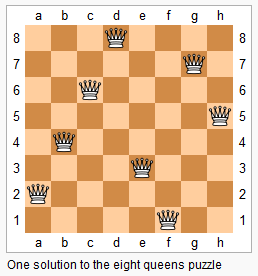The n-queens puzzle is the problem of placing n queens on an n×n chessboard such that no two queens attack each other. Given an integer n, return all distinct solutions to the n-queens puzzle.
Each solution contains a distinct board configuration of the n-queens’ placement, where ‘Q’ and ‘.’ both indicate a queen and an empty space respectively.
Example:Input: 4
Explanation: There exist two distinct solutions to the 4-queens puzzle as shown above.
Backtracking Algorithm for N Queen
The backtracking algorithm is implemented in Recursion where we repeatedly try the valid positions for current queen then next queen and so on. We pass the current solution (for placing the first N queens) into the Recursive function, then we can try N positions for current queen if it does not violate the rules with the existing solution.
1 2 3 4 5 6 7 8 9 10 11 12 13 14 15 16 17 18 19 20 21 22 23 24 25 26 27 28 29 30 31 32 33 34 | class Solution { public: int totalNQueens(int n) { int r = 0; dfs({}, n, r); return r; } private: void dfs(vector<int> cur, int n, int &r) { if (cur.size() == n) { ++ r; return; } for (int i = 0; i < n; ++ i) { if (validQueenPosition(cur, i)) { cur.push_back(i); dfs(cur, n, r); cur.pop_back(); } } } bool validQueenPosition(vector<int> cur, int x) { for (int i = 0; i < cur.size(); ++ i) { // on the same diag if (abs(i - (int)cur.size()) == abs(x - cur[i])) { return false; } // on the same column if (x == cur[i]) return false; } return true; } }; |
class Solution {
public:
int totalNQueens(int n) {
int r = 0;
dfs({}, n, r);
return r;
}
private:
void dfs(vector<int> cur, int n, int &r) {
if (cur.size() == n) {
++ r;
return;
}
for (int i = 0; i < n; ++ i) {
if (validQueenPosition(cur, i)) {
cur.push_back(i);
dfs(cur, n, r);
cur.pop_back();
}
}
}
bool validQueenPosition(vector<int> cur, int x) {
for (int i = 0; i < cur.size(); ++ i) {
// on the same diag
if (abs(i - (int)cur.size()) == abs(x - cur[i])) {
return false;
}
// on the same column
if (x == cur[i]) return false;
}
return true;
}
};If we want the detailed solutions rather than the count, we can modify the DFS (Depth First Search) terminating condition – when N queens are placed successfully.
1 2 3 4 5 6 7 8 9 10 11 12 13 14 15 16 17 18 19 20 21 22 23 24 25 26 27 28 29 30 31 32 33 34 35 36 37 38 39 40 41 | class Solution { public: vector<vector<string>> solveNQueens(int n) { vector<vector<string>> r; dfs({}, n, r); return r; } private: void dfs(vector<int> cur, int n, vector<vector<string>> &r) { if (cur.size() == n) { vector<string> ans; for (const auto &s: cur) { string row(n, '.'); row[s] = 'Q'; ans.push_back(row); } r.push_back(ans); return; } for (int i = 0; i < n; ++ i) { if (validQueenPosition(cur, i)) { cur.push_back(i); dfs(cur, n, r); cur.pop_back(); } } } bool validQueenPosition(vector<int> cur, int x) { for (int i = 0; i < cur.size(); ++ i) { // on the same diag if (abs(i - (int)cur.size()) == abs(x - cur[i])) { return false; } // on the same column if (x == cur[i]) return false; } return true; } }; |
class Solution {
public:
vector<vector<string>> solveNQueens(int n) {
vector<vector<string>> r;
dfs({}, n, r);
return r;
}
private:
void dfs(vector<int> cur, int n, vector<vector<string>> &r) {
if (cur.size() == n) {
vector<string> ans;
for (const auto &s: cur) {
string row(n, '.');
row[s] = 'Q';
ans.push_back(row);
}
r.push_back(ans);
return;
}
for (int i = 0; i < n; ++ i) {
if (validQueenPosition(cur, i)) {
cur.push_back(i);
dfs(cur, n, r);
cur.pop_back();
}
}
}
bool validQueenPosition(vector<int> cur, int x) {
for (int i = 0; i < cur.size(); ++ i) {
// on the same diag
if (abs(i - (int)cur.size()) == abs(x - cur[i])) {
return false;
}
// on the same column
if (x == cur[i]) return false;
}
return true;
}
};We are using the C++ std::string(n, char) constructor to initialise a string that is size n and pre-filled with character char.
Please note that there are faster implementation on finding the number of valid solutions for N queen problem using bitwise techniques: N Queen Problem in Back Tracing, Bit-logics
See other implementations of N-Queen Problems:
- Algorithm to Valid N Queens
- Teaching Kids Programming – Backtracking Algorithm to Solve N-Queen Problem
- Using Recursive Backtracking Algorithm to Solve Classic N Queen Problem
- Find the Queens That Can Attack the King
- N Queen Problem in Back Tracing, Bit-logics
- Coding Exercise – N Queen Problem – C++ – Bit Logics – Shortest and Fastest Solution – Online Judge
- N Queen Problem in Back Tracing, Bit-logics
–EOF (The Ultimate Computing & Technology Blog) —
loading...
Last Post: Using Recursive Merge Sort Algorithm to Sort a Linked List in O(NLogN)
Next Post: Know The Effective and Smart SEO Reporting Tool You Must Use
